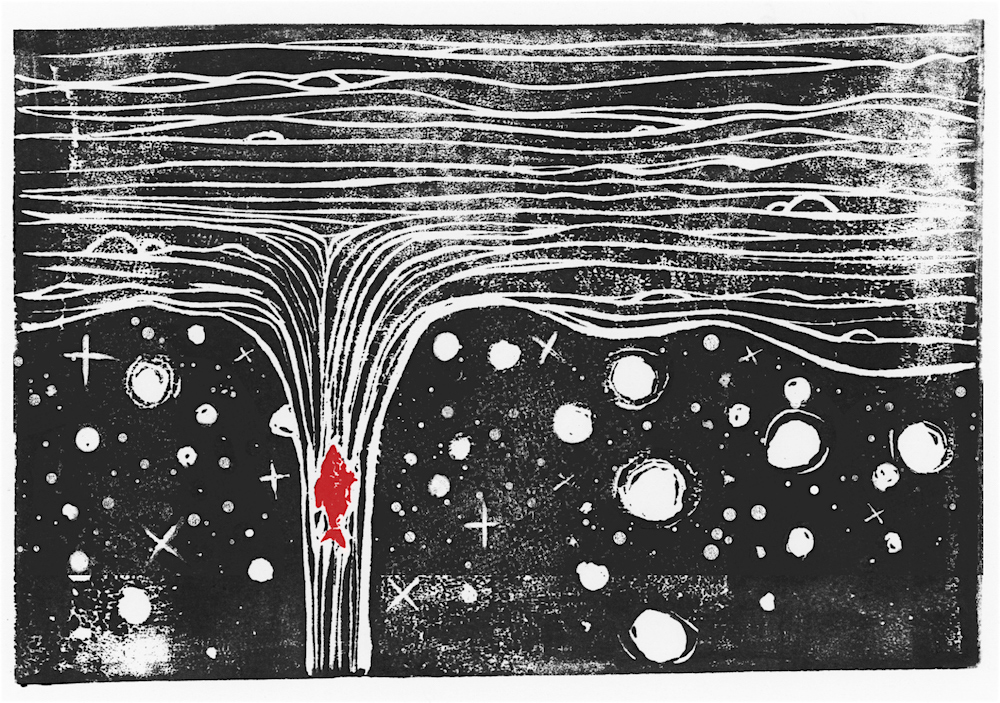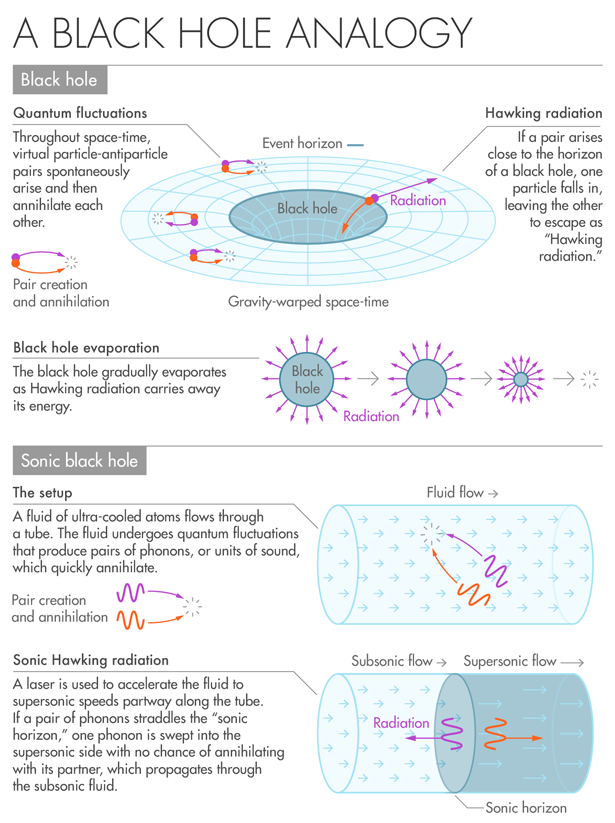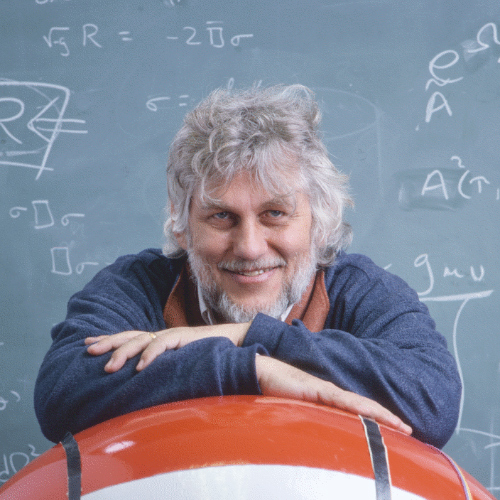What sound black holes can tell us about real
Can a liquid analog of a black hole direct physicists to discoveries in the field of quantum gravity, or is this an unnecessary distraction?

"Red herring", i.e. “Smoked herring” - a phraseological unit to indicate a diversion (herring was used to knock hunting dogs off the track).
In 1972, at a lecture at Oxford University, the young physicist William Unruh asked the audience to introduce fish screaming for fear during the overcoming of the waterfall. Let the water fall so fast that at a certain point it overtakes the speed of sound. Then, after the fish passes this point, the water will fall down faster than sound waves propagate upward along it, and the fish can no longer be heard in the headwaters of the river.
Unruh explained that something like this happens when you fall into a black hole (BH). When you approach one of these superdense objects, the fabric of space-time is bent more and more, which is equivalent to the increase of gravity, according to Einstein's GR. At the point of no return, known as the “event horizon,” the curvature of space-time becomes so strong that the signals can no longer climb out of it. Even the light caught by the BH gravity remains behind the event horizon, which makes the BH invisible.
In the following years, the BHs — the places where GTR and quantum mechanics, the two columns of modern physics, meet and collapse in paradoxes — emerged from the shadows and became leitmotifs of the search for a comprehensive theory of "quantum gravity." Meanwhile, Unruh’s acoustic analogy turned out to be even better than previously thought. In the fruitful work of 1981, op showed that the BH event horizon and sound horizon in systems like a waterfall — now called sound black holes (BHD) —can be described by identical equations. Considering these "amazing mathematical similarities," Unruh, a professor at the University of British Columbia, said that "it seems that if you understand one system, it will help you understand the other."
')
Researchers began to delve into the physics of the SCD in search of clues about real BH. And in recent years, they began to create SCD in laboratories and invent more and more complex experiments with analogies. This summer, Jeff Steinhauer from Technion (Haifa) reported an interesting finding : the discovery of Hawking’s sound analog, a hypothetical BH phenomenon predicted by Stephen Hawking in 1974.

Hawking's prediction of BH heat radiation, due to which they disappear completely over time, leads to the famous “information paradox” asking the question - what happens to the information about what gets into the BH. Hawking's calculations speak about the loss of this information flowing from the Universe when getting into BH. In this case, the entire platform of quantum mechanics, for which information serves as a fundamental and indestructible "currency", collapses. But if information, as most physicists believe, is still preserved, then Hawking is mistaken, and the task of any theory of quantum gravity will be to find inaccuracies in its logic. The informational paradox “exacerbated the tests that must be met in order to understand quantum gravity,” said Raphael Bousso, Hawking’s protégé and theoretical physicist at the University of California at Berkeley.
Hawking's important predictions cannot be verified directly. The emission of real BH is too small to be detected. In this regard, the measurement of a similar effect in the SBS - the quantum units of sound emitted from the sound horizon - raises a long overdue question: are SCPs full analogies of BH? More specifically, does Steinhower's discoveries confirm Hawking’s calculations, thereby proving that information disappears in BH?
“Everyone says, 'Wow, great experiments!',” Says Daniel Fachchio [ Daniele Faccio ], a physicist at Heriot-Watt University (Edinburgh), also studying BH. "But I think that very many people think in this case, 'And what do they mean?'"
Some researchers see indirect evidence of the existence of Hawking radiation in the Steinhauer experiment. In a paper published last month, a former physicist and now a philosopher, Karim Thebault of the University of Bristol, writes that "a BH analog can replace astrophysical BH." Others believe that this only distracts scientists. Daniel Harlow, a theoretical physicist at Harvard University, considered the experiment an "amusing demonstration of engineering ideas" that "does not teach us anything about black holes."
The question of whose interpretation turns out to be correct depends, in general, on what exactly Hawking's calculations of 42 years ago revealed to us about the Universe.
They showed us that the BH is not really black. They glow due to random quantum oscillations. Throughout space-time, pairs of virtual particles constantly appear and annihilate each other. Hawking realized that when these couples appear on the horizon of BH events, one of them can be sucked in, while the other one will run away, which will prevent their mutual destruction. The escaped particle becomes real by stealing the energy of the BH gravitational field. A particle falling inside acquires negative energy, as a result of which the total BH energy decreases [in fact, everything is a little more complicated - approx. trans.]. So, one particle of BH gradually disappears from being, leaving no trace behind. Hawking's calculations show that this radiation will be “thermal”, consisting of a devoid of characteristic features, random distribution of energies, in which no details will be stored about the collapsed star that formed the BH, or about anything else interesting that has fallen into its interior.

William Unruh, a physicist from the University of British Columbia
Here you have a paradox. According to quantum mechanics, the probability of all possible states of particles of the Universe must preserve “unitarity”, developing in such a way that past states of the Universe can in principle be determined by rewinding from the current state. But if during BH evaporation, which turns it into a faceless Hawking radiation gas, information is lost, then the past of the Universe cannot be inferred from the present, and quantum mechanics break down.
Or maybe Hawking was wrong.
For his calculations, he made a key assumption: the space-time is smooth and continues beyond the BH horizon, as it is described by GR. Physicists believe that this is an approximation. If Einstein’s space-time continuum is sufficiently increased, a more fundamental, quantum form of gravity will appear. And although quantum gravity becomes very important near the superdense center of BH, known as singularity, Hawking suggested that this physics of short distances in describing quantum fluctuations on the horizon can be neglected - gravity will be relatively moderate there. According to GR, on the horizon of a typical supermassive BH (such as those found in the centers of galaxies) the curvature of space-time is small enough - such that the astronaut crossing it will not even notice it.
In 1981, Unruh discovered that this approximation system can be applied to liquids. Like space-time, liquids appear continuous on a large scale, although they consist of individual atoms. Unruh showed that just as pairs of particles appear and disappear in space-time, vibrations, called “phonons,” quantum units of sound, should appear in liquids. And when pairs of phonons appear near the sound level of the SBS, they should be broken and transformed into permanent ones, thus generating the Hawking sound analogy.
About this phenomenon in August, Jeff Steinhauer reported in the work for Nature Physics, more often, as he says "all day and every day" just above it since 2009. He created an exotic liquid called the Bose-Einstein condensate from supercooled rubidium atoms. He forced it to flow, and in half the way he fired her from a laser, accelerating it to supersonic speed and creating a sound horizon. Finally, Steinhauer measured quantum entanglement between pairs of phonons on both sides of the horizon, corresponding to Hawking radiation.
The discoveries confirm that the fluid approximation works in the case of BCC. “The question is, how are the approximations related to each other?”, Says Stephan Hartmann , a philosopher of physics from the University of Munich Ludwig-Maximilians. If the BERs serve as a complete analogy, then Hawking’s approximations are correct, the event horizon is unremarkable, and the information in the BH is destroyed. This means that the probabilistic rules of quantum mechanics should be replaced by a more fundamental platform. If the Hawking approximation is wrong, then the BHD is poorly suited to the role of BH, and quantum gravity somehow encodes the history of BH in their radiation, preserving the information when they evaporate.

Jeff Steinhauer, a physicist from Technion (Haifa)
Unruh believes Hawking's approximation is true. In 2005, he and Ralf Schützhold from Duisburg-Essen University (Germany) showed that Hawking radiation stems from reliable theoretical predictions for both BH and real BH, regardless of theoretical assumptions about the details of short-distance physics. And the small-scale properties of space-time or fluid never affect the result of calculations. This means that the Hawking approximation did not miss anything important. Unruh interprets this in such a way that the effects of quantum gravity cannot affect Hawking radiation and save information. In his opinion, the result obtained by Steinhauer adds evidence that “this thermal radiation is a phenomenon that is not very disturbed,” and, consequently, “information is lost.”
But most researchers of quantum gravity still believe that information is preserved - including Hawking, who has migrated to another camp in the 2000s. From their point of view, the Hawking radiation analogue in the BHR says nothing about real BH, since they are fundamentally different. And if the fluid approximation is sufficiently accurate for the BCH, then the space-time may not be approximately smooth on the horizon of the BH events. Somehow, quantum gravity changes horizons — and must do so very strongly in order to overcome the objections of Unruh and Shutskold about the reliability of Hawking radiation. “We are in such a position that one of two serious assumptions must give way,” says Bousso. “But we are not yet sure how to replace GR on the horizon.”
Some thought experiments suggest that BHs may be empty shells that store all information spread on the horizon and project it out into the Universe like holograms. In this case, the fall in the BH will be less like a fish in a waterfall, and more like a collision of an insect with glass.
According to the majority, the comparison with sound BH only underlines the strange properties of the BH and the theory of quantum gravity. Harlow believes that the BERs are not analogs of BH, but something like computer simulations that process incorrect equations. If you wanted to simulate the equations of quantum gravity, “then you would have to find the right answer,” he says. “Now I don’t know what equations you should give out.”
Source: https://habr.com/ru/post/369889/
All Articles